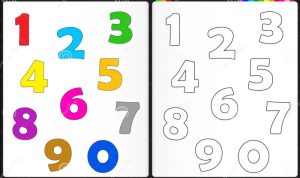Software Options for Photo-to-Coloring Page Conversion: Make Coloring Book Pages From Photos

Make coloring book pages from photos – Converting photographs into line art suitable for coloring pages requires specialized software or online tools. Several options exist, each offering a unique set of features and varying levels of ease of use. The choice depends on factors like budget, technical skill, and desired level of control over the final output.
Software Application Comparison
This section compares three distinct software applications for converting photos into coloring pages. We will consider features, pricing, and ease of use to aid in selecting the best tool for your needs.
| Software Name | Key Features | Pricing | Ease of Use (1-5 stars) |
|---|---|---|---|
| Adobe Photoshop | Powerful image editing capabilities, precise control over line art creation, numerous filters and effects. Supports various file formats and offers advanced layer management. | Subscription-based, various plans available (pricing varies). | ★★★☆☆ (Requires some experience with image editing software) |
| GIMP (GNU Image Manipulation Program) | Free and open-source, provides a wide range of tools for image manipulation, including filters and effects for line art creation. Offers a steep learning curve. | Free | ★★☆☆☆ (Requires significant learning and practice) |
| Autotrace (command-line tool) | Free and open-source, specifically designed for tracing images to create vector graphics suitable for coloring. Requires command-line interface knowledge. | Free | ★☆☆☆☆ (Steep learning curve, requires command-line proficiency) |
Using Adobe Photoshop to Create a Coloring Page, Make coloring book pages from photos
Adobe Photoshop, despite its complexity, offers powerful tools for creating high-quality coloring pages. The following steps Artikel the process:
- Import the Image: Open your chosen photograph in Adobe Photoshop.
- Convert to Grayscale: Go to Image > Mode > Grayscale. This simplifies the image and makes it easier to trace.
- Adjust Levels/Contrast: Use the Levels adjustment (Image > Adjustments > Levels) to enhance contrast and define edges, making the image easier to trace.
- Apply a Filter: Experiment with filters like “Find Edges” (Filter > Stylize > Find Edges) or “Poster Edges” (Filter > Artistic > Poster Edges) to create a line art effect. Adjust filter settings to control line thickness and detail.
- Refine the Lines (Optional): Use the Lasso tool or Pen tool to manually refine or adjust the lines created by the filter for a cleaner, more polished look.
- Clean Up: Remove any unwanted artifacts or stray lines using the Eraser tool or Clone Stamp tool.
- Save as a Coloring Page: Save the image in a suitable format like JPEG or PNG for use as a coloring page.
Image Preparation Techniques for Optimal Results

Preparing your photos correctly is crucial for generating high-quality coloring pages. The success of the conversion process hinges heavily on the image’s initial quality and clarity. Poorly prepared images will result in coloring pages with indistinct lines, muddled details, and an overall unsatisfactory aesthetic. Taking the time for proper preparation ensures a smooth conversion and a superior final product.The clarity and detail present in the original photograph directly impact the final coloring page.
A high-resolution image provides more information for the software to work with, leading to cleaner lines and more intricate details in the finished coloring page. Conversely, low-resolution images result in blurry, pixelated coloring pages unsuitable for printing or enjoyable coloring. Enhancing contrast and detail before conversion further refines the results, making the lines sharper and the different areas of the image more distinct.
Image Resolution and Clarity
High-resolution images are essential for creating detailed and crisp coloring pages. A minimum resolution of 300 DPI (dots per inch) is recommended for printing purposes. Images with lower resolution will appear pixelated and blurry when printed, making them less suitable for coloring. Using image editing software to upscale lower-resolution images can help, but it’s important to be aware that upscaling can introduce artifacts, so starting with a high-resolution image is always preferable.
Consider the intended print size when selecting an image; larger prints require higher resolutions.
Enhancing Contrast and Detail
Several techniques can enhance the contrast and detail in your photos before conversion. Many image editing programs offer tools to adjust brightness, contrast, saturation, and sharpness. For example, in Adobe Photoshop, you can use the “Levels” or “Curves” adjustments to fine-tune the contrast, making the dark areas darker and the light areas lighter. The “Unsharp Mask” filter can enhance the sharpness of edges and details, creating clearer lines for the coloring page.
GIMP, a free and open-source alternative, provides similar functionalities. Careful adjustment is key to avoid over-processing, which can lead to unnatural-looking images.
Suitable and Unsuitable Photo Types
The type of photograph significantly impacts the final coloring page.
- Photos that work well: Images with clear subjects, strong contrasts between light and dark areas, and sharp details are ideal. Photographs of simple objects, line drawings, illustrations, or images with distinct shapes and forms generally produce excellent results. Examples include line art, detailed botanical illustrations, and photographs of simple objects with clean backgrounds.
- Photos that don’t work well: Highly textured images, photographs with significant noise or grain, or images with a shallow depth of field often produce poor results. Photos with blurry or indistinct subjects, and those with subtle color variations, also present challenges. Overly complex images with many small details can also be difficult to convert effectively, leading to cluttered and confusing coloring pages.
Examples include photos with significant motion blur, extremely detailed landscapes, and heavily textured surfaces like fabric or fur.
Creating personalized coloring book pages from your own photographs is a fun and rewarding process. You can easily transform cherished memories into creative activities, and the possibilities are endless! For instance, if you’re looking for inspiration, you might check out pre-made options like the delightful coloring book strawberry shortcake to see how professional designs are structured. Then, apply those principles to your own photo-based coloring pages for a polished, professional result.




